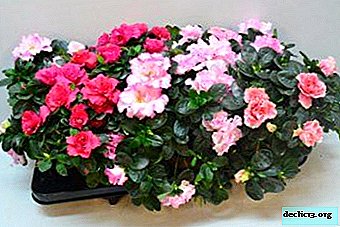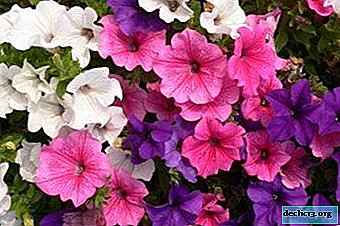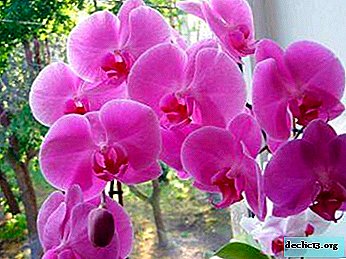Wonderful, or Watermelon Peperomia
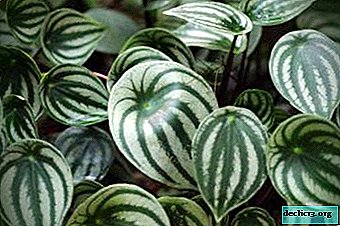
In the home garden, you can often find a plant with fancy flowers and variegated leaves. This is watermelon peperomia, which looks very impressive. From a distance, it seems as if small watermelons stuck around a flower pot.
It grows very slowly and takes up little space. A very unpretentious plant that does not need frequent pruning and huge pots. This article will discuss the conditions for this spectacular flower.
Botanical Description
This small herbaceous plant belongs to the family of pepper Piperaceae, translated as pepper and the same. In nature, watermelon peperonia grows on:
- on soils rich in peat;
- rotting parts of plants;
- tree bark;
- bushes.
Her homeland is South America, where she grows as a groundcover. It is found in India and Southeast Asia.
Watermelon peperomia is also called silver peperomia - Peperomia argyreia. This variety is considered one of the most beautiful representatives of this genus of plants. The most attractive are its striped leaves. Alternating strips of silver and dark green give it a resemblance to a watermelon, which is why it got this name.
Peperomia watermelon low plant with a characteristic color of leaves, grows in height no more than 12 cm. Leaves of her:
- leathery;
- smooth;
- ovoid;
- fleshy.
For a rather small plant, they are large, reaching 5-8 cm in length. They grow on thin stems of a reddish hue. Mostly the flower blooms in summer. Flowers are not distinguished by either smell or special beauty.
Photo
Below you will see a photo of the flower:





Home Care
In order for the watermelon peperomia to please with its beautiful appearance, proper care is needed for it.
Temperature
It is important for a flower to have the optimum temperature in the warm season + 20 ° С ... + 22 ° С. In autumn and winter - + 18 ° С ... + 20 ° С. The temperature of the earth in which watermelon peperomy grows should not fall below 17 ° C. Warm soil is necessary in order for the root system to maintain its viability.
Watering
In summer, the plant is watered when the topsoil is dry, in winter - once every two weeks. If the air in the room is too dry, you need to spray the leaves every day. Watermelon peperomia has a superficial root system, so you need to water it from above.
The plant is particularly sensitive to waterlogging. After watering, drain the water from the pan. For irrigation take water at room temperature, soft, so it must be filtered in advance, boiled or defended.
Shine
Watermelon peperomia refers to variegated varieties that need diffused light. They are advised to be placed on the eastern and western windowsills. In winter, the plant can organize artificial lighting.
Important! Drafts negatively affect the full growth and development of the flower. Therefore, in the winter months, window frames should be insulated.Priming
The main soil requirement for this flower is the presence of a loose structure. This substrate must be moisture- and breathable. In order to get the right soil you need to mix in equal amounts:
- turf and leaf land;
- peat;
- humus;
- coarse sand.
Pruning
Trimming watermelon peperomia is optional, but desirable. Thanks to this procedure, the decorative effect of the flower increases. He's getting more fluffy. Erect shoots should be cut off when they grow to 20-25 cm. 2-4 fresh shoots will grow on the cut-off place.
Top dressing
Fertilize the plant from the end of spring until the beginning of autumn. They are fed with complex mineral fertilizers as described in the instructions.
Transfer
 Up to 3 years, young peperomia should be transplanted annually, and an adult - 1 time in 2 years. The procedure is carried out in April.
Up to 3 years, young peperomia should be transplanted annually, and an adult - 1 time in 2 years. The procedure is carried out in April.
- The first step is to prepare a substrate with the obligatory presence of a drainage layer. This will help water not accumulate in the ground. As a drainage, you can take crushed brick or expanded clay.
- Then the pot must be filled with earth by two-thirds.
- Plant peperomia.
- Deepen it, cover it with a small layer.
- To water.
Pot
For watermelon peperomia, a pot is suitable:
- shallow;
- wide;
- small.
With each transplant, you need to take a pot with a diameter of 1.5-2 cm more.
Wintering
In winter, watermelon peperomia can not be sprayed. It is necessary to ensure that the room is warm, at a temperature of + 15 ° C the plant freezes. In order for the shoots not to stretch, the flower must be additionally highlighted.
Propagation by cuttings, bush and seeds
- In spring or summer, you can propagate the flower with cuttings.
- A sharp knife cuts off the shoot on which there is one or more buds.
- Then it is planted in a substrate and covered with a plastic bottle.
- To root, you need to put in a warm place.
- After 3 weeks, it is planted in a small pot.
- Propagation by seeds involved in March.
- They are presoaked for 1 hour.
- After the seeds are scattered on the surface of the earth and sprinkled on top with a centimeter layer of soil, slightly watered. Cover the container with polyethylene.
- Complete rooting occurs in 1.5-2 months, after which the plants are planted.
- The simplest is reproduction by dividing the bush. It is carefully divided and planted in a pot a little smaller than the one in which the adult plant was located.
About flowering
The flowering process is remembered by the sudden appearance among the leaves of greenish-white, graceful and thin spikelets. They remind ponytails of a plantain. Some inflorescences are replaced by others. Leaves rise in a neat hill.
About Diseases and Pests
Thrips are caused by watermelon peperomia, the larvae of which are on the lower surface of the leaves. A spider mite can be detected by a plaque-like plaque. A flower can get root rot. Stems and leaves rot from excess water and very low temperatures. An incurable disease is the dwarf virus when:
- flowers do not develop;
- leaves bend;
- life cycle is broken.
Similar flowers
There are many colors in something similar to watermelon peperomia.
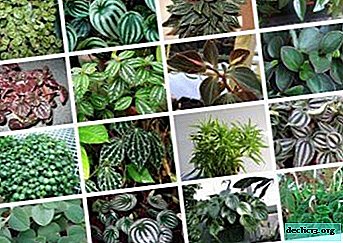 Pepperomy wrinkled - This is a very beautiful corrugated plant. It has dark green leaves; thanks to its short stem, the flower looks elegant and compact.
Pepperomy wrinkled - This is a very beautiful corrugated plant. It has dark green leaves; thanks to its short stem, the flower looks elegant and compact.- Peperomia Lilian outwardly similar to lily flowers. The leaves have an unusual shape in the form of a heart, in which the veins are as if recessed, and the main plate is slightly swollen. They are variegated or with a wax coating, which makes them glossy.
- Peperomia rotundifolia - creeping miniature plant. It has thin reddish stems and round small leaves.
- Gray pepper can grow up to 0.5 m. Young shoots grow vertically, begin to hang over the years. The effect of gray hair creates an edge on the leaves and shoots.
- Marble Peperomia represents a low bush. Her leaves are heart-oval. The color is silver-motley or brownish-green. This view is very adaptable to room conditions.
Such a plant as peperomia has a beneficial effect on the atmosphere in the room. Florists love this plant for its unpretentiousness. It’s not difficult to grow a flower. Watermelon peperomia looks great in compositions with various colors.
Useful video
An illustrative video on watermelon peperonia is attached to the article:

 Pepperomy wrinkled - This is a very beautiful corrugated plant. It has dark green leaves; thanks to its short stem, the flower looks elegant and compact.
Pepperomy wrinkled - This is a very beautiful corrugated plant. It has dark green leaves; thanks to its short stem, the flower looks elegant and compact.





